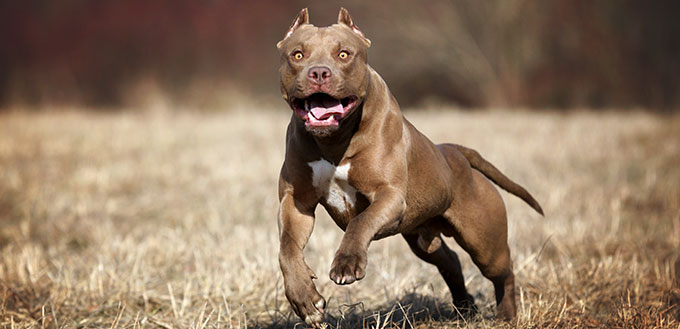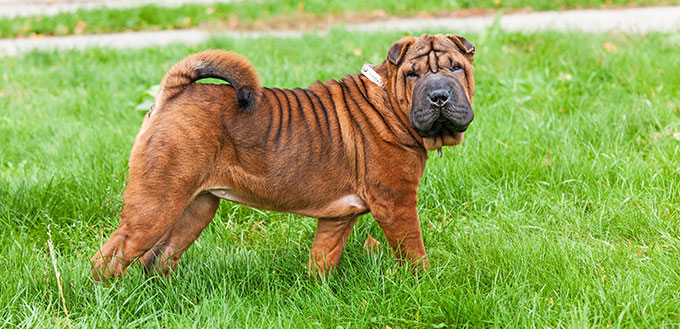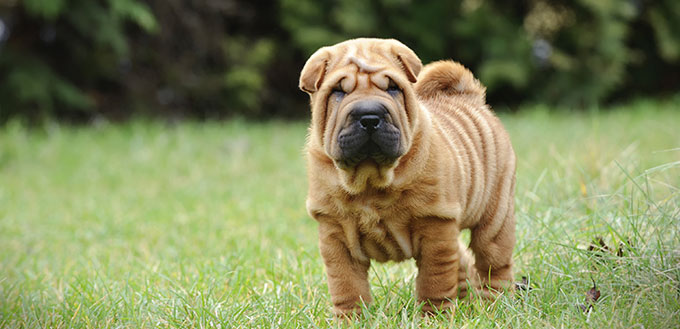For those who favor the protective nature of the Pitbull terrier and the unfettered loyalty of the Shar-Pei, the Shar-Pei Pitbull mix is an ideal breed that combines the best of both worlds. Of course, that’s not to say that they don’t come without their own drawbacks – but their many attributes make these one of the most desirable breeds for a variety of households. Read on to discover whether this variant of the Shar-Pei mix is the ideal fit for your life.
History of the Shar-Pei Pitbull Mix
It is unknown exactly when the Shar-Pei Pitbull mix first officially came to exist, however, they are generally recognized as one of the most recent breeds. Indeed, the Shar-Pei Pitbull Terrier mix is so new that they are not yet registered by the American Kennel Club (AKC). It is generally accepted, however, that the breed looks more like Pit Bulls with some extra rolls and a little extra heftiness that comes from the Shar-Pei parentage. In terms of their personality, the Sharpull Terrier is a little friendlier than their Pitbull Terrier parents, and generally less aloof than the average Shar-Pei dog, too.
Of course, that’s not to say that these breeds don’t come without their own challenges! With the added energy from their Shar-Pei lineage, combined with the stubbornness of the Pitbull Terrier, these dogs will need a firm hand and plenty of socializing to ensure that your mixed breed Pei Pitbull remains a healthy, happy member of the family dynamic.
These days, Shar-Pei Pit mix are members of both the American Canine Hybrid Club and the International Designer Canine Registry – both of which were set up for first-generation mixed breeds to be officially registered. As with all breeders, however, it’s important to be mindful of where you look for your new family member, as puppy farms and poor breeding can lead to health concerns in puppies and poor care for the parents. Of course, as long as owners and breeders follow the correct care, Shar-Pei Pit Bull puppies can be perfectly healthy!
Who are the Parents
Chinese Shar-Pei
The Chinese Shar-Pei is recognized by the AKC, and is one of the oldest breeds in the world, and they were originally bred to meet a wide variety of needs. From guarding and herding to hunting and – sadly – later for fighting, the Shar-Pei dog breed is known for their loose, wrinkly skin (which can sometimes cause the breed to suffer with skin problems) and fierce devotion to their family. Their overall popularity died down after heavy tax levies were introduced on dogs, by the Chinese Communist Party in the 1940’s – being named in the Guinness World Records as “The World’s Rarest Dog” – but Hong Kong continued to breed Shar-Pei’s back to a healthy level. Particularly after they were later introduced to the US in the late 60’s, and became an extremely popular dog breed with individuals and families alike.
Hardy, yet surprisingly adaptable, this dog can even adjust to apartment living (although not ideal, due to their high energy needs) and are best suited to smaller households. That’s not to say that this dog breed can’t live with larger families – but rather that the Shar-Pei’s strong-willed nature, combined with absolute devotion to the pack leader means smaller families and single households make for much better living conditions for this breed. However, with plenty of socialization, exercise and obedience training, this loyal breed can fit with almost any family dynamic.
American Pit Bull Terrier
The American Pitbull Terrier is also recognized by the AKC and is a member of the Terrier Group. Like their predecessors, they can come under many names, including the Pit Bull, Pitdog, Pitbull Terrier and American Staffordshire Terrier. Heavy-set and extremely muscular, the Pitbull is one of the most recognizable dog breeds and unfortunately have a poor reputation amongst the general population. That being said, anyone with experience in handling this breed can tell you that the Pitbull can actually be one of the most gentle and loving dogs – even gaining notoriety as a “nanny dog” due to their intensely protective yet loving nature. When well-socialized, the Pitbull terrier can make for a fantastic companion dog.
Both parents of the Shar-Pei and Pit Bull mix may have a sad – and damaging – background in dog fighting and being used for baiting, but these dog breeds can be extremely loving and highly sensitive to their owners. Add to this the fact that both dog types are highly trainable and it makes sense that a crossbreed of the Shar-Pei and American Pitbull Terrier would be a faithful, loving dog that rarely leaves your side.
A mixture of both parents results in a dog with dark eyes, but a wide range of different coat colors, ranging from red to blue. These designer dogs are bred specifically for their loyal temperament and protective nature. While these characteristics are generally seen as positive, they need an experienced dog owner to understand how to handle training and socialization from a young age.
Quick Facts
- When fully grown, the average Pit Pei mix can weigh up to 48 pounds for males and 40 pounds for females – although some have been known to reach up to 60 pounds!
- The Shar-Pei Pitbull Terrier will grow up to 20 inches in height, although females can be a little shorter.
- On average, the Shar-Pei mix will consume roughly 2.5 cups of food per day
- The Shar-Pei Pitbull mix is best suited to a home with one or two other family members.
- They are extremely active dogs and require ample exercise – up to 14 miles per week, on average!
- Training and socialization is key to a happy pup – focus on these as soon as you can.
- They have been officially recognized by the International Designer Canine Registry, under the breed name of ‘Pit Pei’.
- This breed can go by many names, including the Sharpull Terrier, Chinese Pitbulls, Shar-Pei Pit Bull, Shar-Pei American Terrier, Pei Pit Bull Mix, Pit Pei and the Shar-Pei Pitbull.
Things You Should Know
Training
One of the best things about the Shar-Pei Pitbull Terrier is that they’ve garnered their intelligence from both of their parents. This makes them extremely easy to train, although they require an experienced trainer to understand when the Pei Pitbull is being pushed too far – or not far enough! The Sharpull Terrier puppy will need plenty of exercise too, in order to help them to focus. Otherwise, you might find that your new dog can run you ragged before you’ve even mastered the “sit” command!
For those concerned about their training ability, try not to worry. There are plenty of training tips available on our website and, when in doubt, remember that a little food and a lot of exercise can help any dog. Being such a live-wire and extremely loyal, the Shar-Pei Pitbull Terrier is ideal as a jogging companion, so feel free to bring your dog along with you, once trained – and you’ll soon find your dog is keen to stay, lie down and return on command. They may even be up for some more advanced training, too!
Feeding
Despite being a mixed breed, the Shar-Pei Pitbull Terrier is a dog that will generally look like a Pitbull more than a Shar-Pei. Because of this, their muscular bodies will require more food, and particularly more protein than other dog breeds. Sharpull Terriers therefore need a high-protein diet to keep their muscles healthy, and ready to support their joints. It’s also a good idea to invest in the best dog food available, with added vitamins and minerals, as well as high-quality carbs and fats from natural sources. This can help offset any potential health issues that come with being such a heavy-set breed.
Feed your Terrier Sharpull dog one to three cups of food per day, depending on their size, divided between two meals. Be aware that these dogs can become prone to weight problems, so always watch and adjust feeding levels and schedules to best maintain a healthy muscle and bone structure, and avoid obesity, which can add immense pressure to the joints.
Grooming
As well as having wrinkly skin, the Shar Pei dog breed is known for having ‘sand skin’ which can be very coarse. However, the shorter, silkier fur of the Pitbull lineage can help your Shar-Pei Pitbull Terrier to have a slightly easier to manage coat, with fewer health problems that come with this gene pool. Their shorter, stiff coat will need weekly brushing – as well as regular grooming between, depending on how messy they like to get during walkies. Using a soft bristle brush is best, as this won’t be too harsh on the skin or remove any natural oils your dog creates to keep their skin healthy.
A Shar-Pei Pitbull mix, like many other dog breeds, will require regular nail trims if they aren’t walked over hard surfaces (such as concrete) often. Once or twice a month will be required if they aren’t naturally worn down when exercising, to help stop paws and claws from becoming uncomfortable or injured, which can even lead to infection.
If you have your Shar-Pei mix from a young age, consider handling their paws, ears and muzzle early on. This will help your dog become used to regular handling and make it much easier for you to groom and trim your dog as required, as they grow older.
Health
Sadly, both Shar-Pei’s and Pitbull Terriers are known to suffer from a wide range of different health problems. However, because the Pit Pei is a mixed breed, health issues may be reduced through the expanded genetic makeup. Of course, that’s not to say that their build and parentage may lead to some issues down the line, and so we recommend becoming familiar with common issues that are known to their parent breeds.
- Patellar Luxation: Essentially, this is a dislocated knee cap, in that the cap itself moves away from the groove that it is usually placed in. It can come as a result of injury, or from an over-exerted puppy, affecting up to 7% of all puppies.
- Eye Problems: Commonly caused by the skin folds in Shar-Pei breeds, who have deep-set eyes and little structural integrity around the socket, owners should away that Shar-Pei mix may suffer from eye problems. If your dog starts to rub at their eyes or excessively tear, a trip to the vet may be in order.
- Hip Dysplasia: Common in many dogs, hip problems can usually be ruled out with ethical breeding practices. For this reason, we recommend searching for a reputable breeder with knowledge of the Pei Pitbull mix.
- Heart Problems: Due to their bulky, heavy-set physical stature, the Sharpull Terrier can develop heart problems not entirely dissimilar to their parents. While a good breeder is a key to finding a healthy dog, it is also worth noting that ample exercise and activity can also work to reduce problems with the heart.
Temperament
The Shar-Pei Pitbull mix temperament makes them extremely responsive to training – and this is something that should be utilized as early as possible. The gene pool used to create these pups both harness the protector instinct, which can become overwhelming if the Sharpull Terrier does not undergo a wide range of socialization to help desensitize this protective nature from early on. Training can be something as simple of teaching your dog about sharing toys and going on long walks in a wide range of different areas, through to more formal training at the local center, where your canine companion will also learn to handle being around lots of people and pups at once.
The Shar-Pei Pitbull Terrier has inherited some of the guarding tendencies from both parents, and can therefore be a little protective of their food. Teaching them about sharing from an early age can help ensure that your dog knows that you don’t mean to steal their food, and will reduce any food aggression that comes with their nature.










